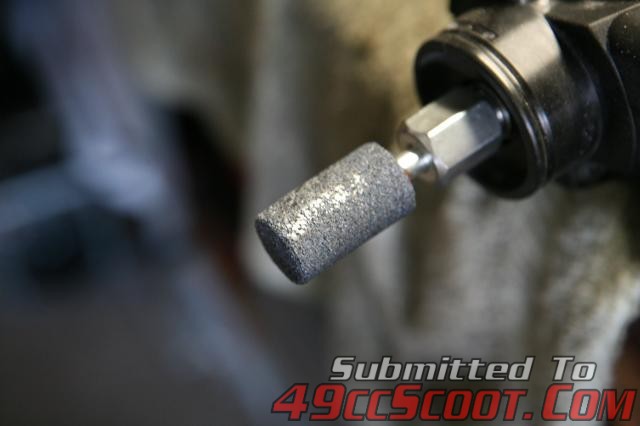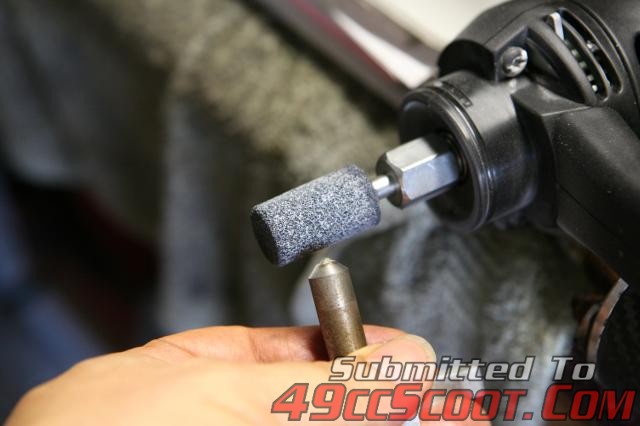Post by waltinhawaii on Oct 14, 2013 1:01:24 GMT -5
Something came up during my build, I was using a 1/4" stone in a high speed grinder and after a few minutes it loaded up with steel in the grinding stone. So I figured I'd better put up a small tutorial for you folks out there like me, who is pretty much completely self taught (i.e., took me a damn long time to learn what I needed to know).
Most of us have used shop grinders in the usual 6" or 8" wheels to sharpen tools or grinding parts. What always impressed me was how well they worked when the wheels were fresh and new, and how quickly they became dull and would no longer cut or grind, just make the metal shiny and really hot. No one told me anything about them.
Wheels come in different roughness, of course; everyone knows that. But not many people realize they also come in different hardness. A wheel is supposed to wear... if what you are grinding and your wheel hardness is well matched, then the wheel will wear away into dust just as your metal is cut. That way, a new, fresh layer of wheel surface is always available each time you use it. But for me, and probably for most of you, that wasn't the case. The wheel would clog up or "load up" and then it will just make your workpiece hot but not grind it much, and the cutting action is severely limited. This happened to me just now on this grinding stone on my grinder (but same thing applies to all stone grinding wheels):

As you can see, the stone is shiny due to all the steel that is stuck inside and bonded to the stone. So, when you use such a stone it doesn't cut very well. If you buy a grinder it will usually come with a little doohicky that looks like a bunch of little steel 'star' wheels strung together. This is supposed to be held against your stone to even out the surface and make it flat, and to renew the surface when the metal clogs up the stone. I'd tried a few of those and they worked about as well as the anti shark sprays did in the 70's.
So I bought a synthetic diamond, it is mounted in a metal stick, you can get them in all kinds of sizes:

Here, I've used the diamond to lightly run across the stone surface (called "dressing") and it scrapes off the metal and exposes new, sharp stone to do a much better job at cutting. You don't have to take off much, just run it lightly across the surface of the stone 2 or 3 times while it's running and you will have a fresh sharp stone that cuts great again.
A couple of tips: the synthetic diamonds aren't cheap, but the small ones work just as well as the big ones, so buy a medium to small one and you'll be fine, those are much cheaper than the big ones. When you dress the stone, hold the diamond pointed down, slightly away from the surface, this helps with longevity of your diamond. Don't think about using your wife's ring or you will get very intimate with your dog's living accomodations.
SURVIVAL TIPS:
When installing a grinding stone on your grinder (6" or 8" or 10", not the little dremel types), ALWAYS 'ring' the stone first. Put a handle on the stone, you can use a string or wire; then tap it gently with a piece of hardwood or the handle of your hammer. It should 'ring' with a pleasant tone. If you hear a dull 'thud' then the stone has a crack in it and will grenade on you when you turn it on. BREAK the stone in half and throw it away. If in doubt, throw it away. always break them first so others won't be tempted to dumpster dive and re use them and get hurt.
Always switch the grinder on, then immediately turn away (I step to the side and put a cabinet in between myself and the machine) and wait a few seconds until it spools up and reaches top speed. After a few seconds at top speed it should be fine to start your work.
In my picture above, you can see I've mounted my diamond into a small plate. The plate follows the little table next to the grinding stone so that the surface is retouched into a nice flat surface without grooves.
Good luck!
walt
Most of us have used shop grinders in the usual 6" or 8" wheels to sharpen tools or grinding parts. What always impressed me was how well they worked when the wheels were fresh and new, and how quickly they became dull and would no longer cut or grind, just make the metal shiny and really hot. No one told me anything about them.
Wheels come in different roughness, of course; everyone knows that. But not many people realize they also come in different hardness. A wheel is supposed to wear... if what you are grinding and your wheel hardness is well matched, then the wheel will wear away into dust just as your metal is cut. That way, a new, fresh layer of wheel surface is always available each time you use it. But for me, and probably for most of you, that wasn't the case. The wheel would clog up or "load up" and then it will just make your workpiece hot but not grind it much, and the cutting action is severely limited. This happened to me just now on this grinding stone on my grinder (but same thing applies to all stone grinding wheels):

As you can see, the stone is shiny due to all the steel that is stuck inside and bonded to the stone. So, when you use such a stone it doesn't cut very well. If you buy a grinder it will usually come with a little doohicky that looks like a bunch of little steel 'star' wheels strung together. This is supposed to be held against your stone to even out the surface and make it flat, and to renew the surface when the metal clogs up the stone. I'd tried a few of those and they worked about as well as the anti shark sprays did in the 70's.
So I bought a synthetic diamond, it is mounted in a metal stick, you can get them in all kinds of sizes:

Here, I've used the diamond to lightly run across the stone surface (called "dressing") and it scrapes off the metal and exposes new, sharp stone to do a much better job at cutting. You don't have to take off much, just run it lightly across the surface of the stone 2 or 3 times while it's running and you will have a fresh sharp stone that cuts great again.
A couple of tips: the synthetic diamonds aren't cheap, but the small ones work just as well as the big ones, so buy a medium to small one and you'll be fine, those are much cheaper than the big ones. When you dress the stone, hold the diamond pointed down, slightly away from the surface, this helps with longevity of your diamond. Don't think about using your wife's ring or you will get very intimate with your dog's living accomodations.
SURVIVAL TIPS:
When installing a grinding stone on your grinder (6" or 8" or 10", not the little dremel types), ALWAYS 'ring' the stone first. Put a handle on the stone, you can use a string or wire; then tap it gently with a piece of hardwood or the handle of your hammer. It should 'ring' with a pleasant tone. If you hear a dull 'thud' then the stone has a crack in it and will grenade on you when you turn it on. BREAK the stone in half and throw it away. If in doubt, throw it away. always break them first so others won't be tempted to dumpster dive and re use them and get hurt.
Always switch the grinder on, then immediately turn away (I step to the side and put a cabinet in between myself and the machine) and wait a few seconds until it spools up and reaches top speed. After a few seconds at top speed it should be fine to start your work.
In my picture above, you can see I've mounted my diamond into a small plate. The plate follows the little table next to the grinding stone so that the surface is retouched into a nice flat surface without grooves.
Good luck!
walt

